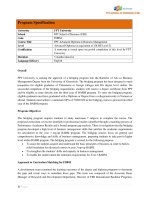btec level 4 hnd diploma in business unit 1 business and business environment
Bạn đang xem bản rút gọn của tài liệu. Xem và tải ngay bản đầy đủ của tài liệu tại đây (4.55 MB, 62 trang )
<span class="text_page_counter">Trang 1</span><div class="page_container" data-page="1">
<b>ASSIGNMENT 1 FRONT SHEET </b>
<b>Unit number and title Unit 1: Business and Business Environment </b>
</div><span class="text_page_counter">Trang 3</span><div class="page_container" data-page="3"><b>❒ Summative Feedback: </b>❒<b>❒ Resubmission Feedback: </b>
Internal Verifier’s Comments:
</div><span class="text_page_counter">Trang 4</span><div class="page_container" data-page="4"><b>Signature & Date: </b>
</div><span class="text_page_counter">Trang 6</span><div class="page_container" data-page="6"><b>3.4. Large business ... 15 </b>
<b>IV. SIZE AND SCOPE OF MASAN GROUP ... 15 </b>
<b>4.1. Introduction to Masan Group ... 15 </b>
<i><b>4.1.1.Vision</b></i> ... 16
<i><b>4.1.2.Mission</b></i> ... 17
<i><b>4.1.3.Goals</b></i>... 17
<i><b>4.1.4. Core value ... 17 </b></i>
<b>4.2. Size and scope ... 18 </b>
<i><b>4.2.1. Size of Masan Group ... 18 </b></i>
<i><b>4.2.2. Scope of Masan Group ... 19 </b></i>
</div><span class="text_page_counter">Trang 7</span><div class="page_container" data-page="7"><i><b>4.2.3. Total amount of capital ... 20 </b></i>
<i><b>4.2.4. Total equity... 21 </b></i>
<i><b>4.2.5. The total revenue ... 21 </b></i>
<i><b>4.2.6. The total employees ... 22 </b></i>
</div><span class="text_page_counter">Trang 9</span><div class="page_container" data-page="9"><b>I. INTRODUCTION </b>
People have more educated and wise options in their investing selections as the country improves. As a business analyst at VCBF (Vietcombank Fund), I analyzed and researched the operations of Masan Group to determine the factors that meet all of the requirements that VCBF can invest in long-term in the 2020-2025 period, including in-depth research on the type, size and scope, functions, and organizational structure.
The business environment is the sum total of factors, factors (external and internal) interacting with each other, directly and indirectly affecting business activities of enterprises. Stemming from this concept, the business environment can be considered as the limit of the space in which a business exists and develops.
This report will highlight three key points related to the business environment. That is the main feature of the types and purposes of business organizations with different legal structures, size and scope of Masan Consumer, followed by the interrelationships of the various organizational functions associated with their business structure.
<b>2.1. Private sector </b>
<i><b>2.1.1. Private sector </b></i>
The private sector is that part of the economy where ownership and control of the –organization are in the hands of private individuals or groups and where profit-seeking is a central goal. <i>(Worthington, Britton, and Thompson, 2018)</i>. The private sector is run by individuals or firms and not the government. Some of its types include sole proprietorship,
</div><span class="text_page_counter">Trang 10</span><div class="page_container" data-page="10">company, and partnership firms.
The capital for the private business is arranged by the business owners, shareholders, bank loans, or any combinations of the above.
As opposed to the public sector that the government operates, the primary objectives of the private sector are profit maximization and acting in the best interest of the stakeholders. Although focused on profit maximization, private firms help economic development by
enhancing the GDP, employment rate, per capita income, infrastructural facilities, etc.
</div><span class="text_page_counter">Trang 11</span><div class="page_container" data-page="11"><i><b>2.1.2. The legal structure </b></i>
The legal structure of the private sector consists of a sole trader; partnership; “registered” limited companies.
<i><b>2.1.2.1. Sole trader </b></i>
Sole trader is a business owned by one individual who is self-employed and who may, in some
<i>cases, employ other people on either a full-time or a part-time basis. (Worthington, Britton, and Thompson, 2018). Sole traders are self-employed individuals who own and operate their own firm. In </i>
other words, there is no legal separation between you and your firm, which is why sole traders are sometimes referred to as sole traders.
<i><b>2.1.2.3. The disadvantages </b></i>
Unlimited liability
</div><span class="text_page_counter">Trang 12</span><div class="page_container" data-page="12">Potential credibility issues Sole responsibility
Fewer tax planning opportunities Barriers to finance
Sale limitations
<i><b>2.1.3. Partnership </b></i>
A partnership is a formal arrangement by two or more parties to manage and operate a business and share its profits. There are several types of partnership arrangements. In particular, in a partnership
</div><span class="text_page_counter">Trang 13</span><div class="page_container" data-page="13">business, all partners share liabilities and profits equally, while in others, partners may have limited liability
A partnership is an arrangement between two or more people to oversee business operations and share its profits and liabilities.
In a general partnership company, all members share both profits and liabilities. There may be tax benefits to a partnership compared to a corporation.
<i><b>2.1.4. “Registered” limited companies </b></i>
A limited company is a type of business structure that has been incorporated at Companies House as a legal ‘person’. It is completely separate from its owners, it can enter into contracts in its own name, and it is responsible for its own actions, finances, and liabilities.
From 1 to 50 members: a limit of 50 Legal entity status
Liability of members: Limited 2 types:
Limited liability company with 1 member.
Limited liability company with equal or more than 2 members.
<i><b>2.1.5. Sub Conclusion </b></i>–
The private sector is a very diverse sector and makes up a big part of many economies. It is based on many different individuals, partnerships, and groups. Types of private-sector business include:
Sole proprietorships Partnerships
</div><span class="text_page_counter">Trang 14</span><div class="page_container" data-page="14">Small and mid-sized businesses Large corporations and multinationals Professional and trade associations Trade unions
Even though the state may control the private sector, the government does legally regulate it. Any
<i>business or corporate entity operating in that country must operate under the laws. (Private Sector Definition, 2020) </i>
</div><span class="text_page_counter">Trang 15</span><div class="page_container" data-page="15">The purpose private sector is for-profit and to become a leading organization in its line of business. To own the whole amount of profit and for the personal touch and personal contact with the customers and easy maintenance of the business.
<i><b>2.1.6. Example </b></i>
Hoa Phat Group
Hoa Phat group is a private sector Founded year: 01/08/1992 Stock code: HBG
Tax source code: 0900189284
Headquarters: Pho Noi A Industrial Park - Giai Pham Commune - Yen My District - Hung Yen Province Authorized capital: 21.239.071.660.000 VNĐ
Founding member Chairman of the BOD: Mr. Tran Dinh Long
</div><span class="text_page_counter">Trang 16</span><div class="page_container" data-page="16">Figure 1: Chart of shareholder structure
<i>(Source: Annual report, 2021) </i>
</div><span class="text_page_counter">Trang 17</span><div class="page_container" data-page="17"><b>2.2. Public sector </b>
Public sector is that part of the economy under the control of the government and its agencies –and where the state establishes and runs the different types of an organization on behalf of its citizens and for their general well-being<i>. (Worthington, Britton, and Thompson, 2018)</i>
<i><b>2.2.1. The types of the public sector </b></i>
Public sector organizations are formed in three different forms: Departmental undertakings
Public corporations/statutory corporations Government company
<i><b>2.2.2.Departmental Undertakings</b></i>
This is the most traditional type of public-sector enterprise. One of the departments of the government is the departmental undertaking. It does not exist independently of the government. It operates under the direction of a single government ministry or department.
The main characteristics:
They operate under the overall control of one of the ministries of central or state government. They are a part of government only, there is no separate entity.
The revenue of departmental undertakings is deposited in the treasury of government. They are financed from the annual budgets of the government.
<i><b>2.2.3. Public corporation </b></i>
Public corporation is a legal entity established by a special act of parliament or by a state or federalnn legislature. It is entirely subsidized by the government. The legislature determines its powers,
</div><span class="text_page_counter">Trang 18</span><div class="page_container" data-page="18">objectives, and constraints, among other things. The main characteristics:
It is created by an act of parliament or central or state legislature.
The powers, objectives & limitations of a public corporation are defined in the act only. Under total control of central or state government operations of public corporations takes place. A public corporation is a separate legal entity. It gets incorporated automatically when the act is
passed in the parliament.
</div><span class="text_page_counter">Trang 19</span><div class="page_container" data-page="19"><i><b>2.2.4. Government Companies </b></i>
Government Firm is a company in which the central or state government owns at least 51 percent of the paid-up share capital, or when the central or state government owns a portion of the paid-up share capital. Like any other registered company, government firms are managed and ruled by the rules of the Companies Act, 2013.
government & other shareholders. The government has the authority to appoint a majority of the directors.
<i><b>2.2.5. Example </b></i>
</div><span class="text_page_counter">Trang 20</span><div class="page_container" data-page="20">Figure 2: Logo Vietnam Airlines
<i>(Source: Vietnam Airlines | S</i>ải cánh vươn cao | Website chính thứ<i>c, 2022) </i>
Vietnam Airlines: the flag carrier of Vietnam. The airline was founded in 1956 and later established as a state-owned enterprise in April 1989. Vietnam Airlines is headquartered in Long Bien District, Hanoi, with hubs at Noi Bai International Airport and Tan Son Nhat International Airport. The airline flies to 64 destinations in 17 countries, excluding codeshared services.
</div><span class="text_page_counter">Trang 21</span><div class="page_container" data-page="21">Name : Vietnam Airlines JSC
Business registration certificate for Joint Stock Company number 0100107518, issued by Hanoi Department of Planning and Investment, and registered for the 6th change on 26 February 2019. Charter capital: VND 14,182,908,470,000
Ticker: HVN. Par value: VND 10,000/share - Total number of outstanding shares: 1,418,290,847 shares (as of 31 December 2020)
The resion Vietnam Airlines is Public Sector:
+ Government Occupied: 86,19% (HVN | Cổ đông lớn | Danh sách các cổ đông lớn, quan tr ng ọcủa doanh nghi p, 2022) ệ
+ Core values: corporate social responsibility is a business practice to ensure all decisions made and actions taken are in line with social sustainability.
<b>2.3. Voluntary sector </b>
The voluntary sector comprises those organizations, including charities, voluntary bodies, and –community businesses, that are not-for-profit enterprises and non-governmental (Worthington, Britton, and Thompson, 2018).
The voluntary sector plays an important role in providing services in the community. The organization serves specific client groups and, although they may make a charge for their services, they are non-profitmaking. Whereas the primary goal of private sector organizations is to make a profit for shareholders.
<i><b>2.3.1. Types of voluntary sector </b></i>
Social enterprise.
</div><span class="text_page_counter">Trang 22</span><div class="page_container" data-page="22">Social enterprises are businesses that put the interests of people and planet ahead of shareholder gain. These businesses are driven by a social/environmental mission and reinvest profits into creating positive social change.
Non-government organization.
A non-governmental organization (NGO) is a non-profit group that functions independently of any government. NGOs, sometimes called civil societies, are organized on community, national and international levels to serve a social or political goal such as humanitarian causes or the environment.
</div><span class="text_page_counter">Trang 23</span><div class="page_container" data-page="23"><i><b>2.3.2. Social enterprise </b></i>
The voluntary sector plays an important role in providing services in the community. The organization serves specific client groups and, although they may make a charge for their services, they are non-profitmaking. Whereas the primary goal of private sector organizations is to make a profit for shareholders.
<i><b>2.3.3. Features </b></i>
Conduct business as usual.
Profit is not distributed to owners/no dividend is allocated. Profit for reinvestment or other social rescue/public benefits. Tax advantages.
Like corporate communication systems, they aim to make a profit, but it’s what they do with the profits that set them apart-reinvest or donate to create positive social changes. More importantly, social enterprises are located in our communities. Social enterprises are businesses that are changing the world for the better.
<i><b>2.3.4. Purposes </b></i>
Not profit.
For the benefit to society: the interests of the public at large. `
Social goals: environment, fair trade, community support, poverty eradication…
<i><b>2.3.5. Example: </b></i>KOTO - Voluntary sector
</div><span class="text_page_counter">Trang 24</span><div class="page_container" data-page="24">Figure 2: KOTO Logo
<i>(Source: Dining with a difference at KOTO, 2022) </i>
</div><span class="text_page_counter">Trang 25</span><div class="page_container" data-page="25">Social enterprise - KOTO, short for & quot; Know One, Teach One & quot; Maintain 100% employment rate of KOTO students Enterprises registered for establishment under the provisions of the Enterprise Law 2014: KOTO is recognized as the first Social Enterprise in Vietnam. The enterprise has operational objectives to solve social and environmental problems for the benefit of the community: searching for children in difficult circumstances, carefully reviewing conditions and identities, ability to ensure they can attend school KOTO Enterprises use all profits to reinvest to realize social and environmental goals: KOTO is currently divided into two independent operating divisions: KOTO Foundation focuses on training street children and young people in difficult circumstances besides KOTO Enterprise, the restaurant business dedicates all profits to the budget brother KOTO Foundation.
<b>III. EXPLAIN THE SIZE AND SCOPE OF A RANGE OF DIFFERENT TYPES IN VIET NAM 3.1. Micro business </b>
A microbusiness is a subcategory of a small business, defined specifically by its small number of employees, annual revenue, and startup costs. Microbusinesses are often run by solo preneurs, freelancers, and side hustlers who begin a business with very small operational and capital needs. Micro enterprises operate in the following fields: Number of employees participating in social insurance: no more than 10 people per year on average; Total source of capital: no more than 03 billion VND; Total revenue: no more than 03 billion VND/year. <i>( Decree 80/2021/NĐ-CP)</i>
Example: Ms. Lo Thi Thong, the owner of Muong Then Cuisine Co., Ltd., a firm that does business in the domains of agriculture and services, employs 25 people, with an average of 10 persons participating in social insurance each year. The entire capital of the corporation is 2.5 billion VND.
<b>3.2. Small business </b>
</div><span class="text_page_counter">Trang 26</span><div class="page_container" data-page="26">Small enterprises in the fields of agriculture, forestry, fishery, industry, and construction with an average annual number of social insurance participants of not more than 100 people and a total annual turnover of not more than VND 50 billion, or a total capital of not more than VND 20 billion, but not a microenterprise as defined in Clause 1 of this Article.<i> ( Decree 80/2021/NĐ-CP)</i>
Small businesses in the sphere of commerce and services with a total annual income of not more than VND 100 billion or a total capital of not more than VND 50 billion, but not a micro-enterprise as defined in Clause 1 of this Article.
</div><span class="text_page_counter">Trang 35</span><div class="page_container" data-page="35"><i><b>4.1.4.4. Trust </b></i>
We believe each individual, when trusted, will perform better. We respect our colleagues, partners, and consumers, treating all fairly. We believe we are strong when we trust each other.
<i><b>4.1.4.5. Passion for winning </b></i>
We want to be one of the first internationally recognized Vietnamese companies as a consumer unicorn.
We always aim for the best results in everything we do. Our strength is our perseverance until reaching success
<b>4.2. Size and scope </b>
<i><b> Size of Masan Group </b></i>
</div>








